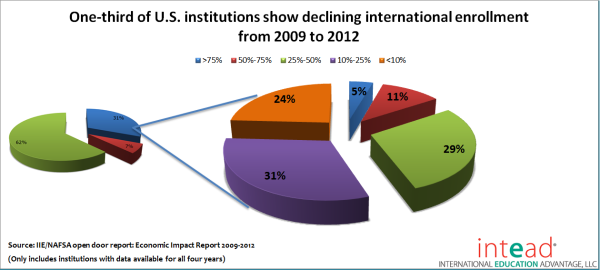Universities rarely go out of business or let's say out of existence. Maybe we should carefully add "so far" since we know that financial pressures are increasing dramatically. Competition is intensifying. Public funding has decreased and as we all know tuition has increased to a level where it is difficult to raise net tuition. Students and their parents are more reluctant or unable to take on the financial burden. I am a strong believer that education is one of the best investments young people can ever make. Financial pressures, among other reasons, have pushed many colleges to recruit more international students. Full paying students are rare in the United States, so adding a cohort of more or less full paying international students can make a difference. As a result, we see many universities entering the international markets. And by the way, we don't mind since we enjoy working with colleges and it is helping us grow our business as well.
Yet, we have to be honest that many colleges do not have the wherewithal to recruit successfully internationally. What do I mean? If you want international diversification on your campus, which is a critical component of a well-rounded education from my perspective, you can mostly achieve that by recruiting diverse U.S. students and adding international exchange students. Obviously internationalization of a campus has many more elements and involves the mix and activities of faculty, research performed on campus, and programming to engage diverse groups of students; this is not the topic of this article. Tuition revenue is always a consideration with any program implementation but will be a secondary or non consideration for the diversification focus of your strategy.
When it comes to building successful international enrollment plans, you need to put in place the right conditions. You must build institutional commitment, a medium to long term plan, or you may not be able to start. We don’t believe that there is one type or another of college that can or cannot be successful in attracting international students. We understand that a university in one of the urban East or West Coast cities may have an easier time to market location. A high U.S. News & World Report ranking helps signifcantly, too. But we have seen many successful implementations through the dedication and development of recruiting and academic resources.
At the same time, we hear from colleges, “we are going to invest more once we have the first tuition revenue." You may be sorely disappointed. It is likely that you will not build enough momentum. So be prepared to invest for a number of years. Beyond that we have seen successful models that link revenue and investment. We strongly believe in the revenue sharing model deployed by the University of Cincinnati and others into performance-based reinvestment whereby incremental tuition revenue from international students is shared between funding existing programs and reinvestment. This is a sound strategy. But this strategy will still require a substantial initial investment and time commitment. In particular, smaller colleges in less well known locations will need time to build experience, a network of contacts and some brand recognition.
We analyzed the Open Door data to look at 1,800 colleges and universities and it showed that one third of the U.S. institutions represented in the survey showed a decline of international students from 2009 to 2012.

So what is a senior academic administrator to do as choices become limited to identify new sources of students? During the last few years, we have seen more institutions increasing their geographic recruiting areas in the United States. The Michigan institutions are offering in-state tuition to Ohio students and vice versa. It makes intuitive sense to broaden your marketing to adjacent geographic areas. In particular, the Midwest and Northeast with an abundance of schools and declining number of incoming students are in need of more students. The obvious pitfall is the zero-sum game within these regions. Have a look at our blog on Demography as Destiny: How it will affect your enrollment. The blog is based on Wiche’s interactive map regarding high school enrollment trends from now until 2020.
All domestic colleges compete for the same fixed pool of incoming undergraduate students, which depends on the demographics of your particular region and the United States as a whole. So why not go to the regions of the United States with increasing population groups in the South, Southwest and West. Indeed, many institutions, appear to have started recruiting there as well, though we have not seen any hard data. Two challenges:
- The increase in the absolute number of potential students is overstating the increase in the potential college students due the demographic shifts. Hispanics, which are the fastest growing group of 18-year-olds have a lower propensity to attend university.
- Geographic mobility is limited. Kids from Florida, Texas and California have a lower propensity to move to the Midwest or even the Northeast.
You could almost say, maybe it's easier to get kids from China or India to move to the Midwest than Californians? Plus, you are marketing to a growing pool of students in these countries. The international pie is increasing more rapidly, even in China where the demographics will turn in the future.
Our conclusion is that active international recruitment is not for everybody. International recruitment requires support across the campus to establish the necessary support services. The resource needs are greater than many expect, including the establishment and support of agency- based recruitment. Yet international enrollment and overall campus internationalization can and should be an exciting and worthwhile investment. This requires medium to long-term planning with the appropriate institutional commitment and resource allocation.

